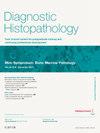皮肤未分化的圆形细胞肉瘤
引用次数: 0
摘要
未分化圆细胞肉瘤是一种异质性的骨/软组织肿瘤,其特征是相对单一的小蓝色圆细胞形态,具有高核/胞质比和非特异性或重叠的免疫组织化学结果。根据WHO软组织和骨肿瘤分类,这一组包括Ewing肉瘤、cic重排肉瘤、BCOR基因改变肉瘤和EWSR1::非ets融合的圆细胞肉瘤。虽然它们在皮肤/皮下定位中相当罕见,但它们应始终包括在低分化圆细胞皮肤肿瘤的鉴别诊断中。其中,皮下尤因肉瘤和浅表CIC重排肉瘤是最常见的实体,它们之间的区别非常重要,因为尤因肉瘤的预后明显更好,特别是在浅表位置,而CIC重排肉瘤是一种高度侵袭性的肉瘤,临床预后较差。诊断确认需要分子分析,它包括FISH,标准的基于测序的方法以及最近的DNA甲基化分析。本文概述了关于未分化皮肤圆细胞肉瘤的当代知识,重点是组织学和免疫组织化学特征以及诊断陷阱,包括鉴别诊断和分子检测中潜在的假阴性结果。本文章由计算机程序翻译,如有差异,请以英文原文为准。
Undifferentiated round cell sarcomas of the skin
Undifferentiated round cell sarcomas are a heterogenous group of bone/soft tissue neoplasms characterized by relatively monotonous small blue round cell morphology, with high nuclear/cytoplasmic ratio and unspecific or overlapping immunohistochemical findings. According to the WHO Classification of Tumors of Soft tissue and Bone, this group includes Ewing sarcoma, CIC-rearranged sarcoma, sarcoma with BCOR genetic alterations, and round cell sarcoma with EWSR1::non-ETS fusions. Although they are quite rare in cutaneous/subcutaneous localization, they should always be included in the differential diagnosis of poorly differentiated round cell cutaneous tumors. Among them, subcutaneous/cutaneous Ewing sarcoma and superficial CIC- rearranged sarcoma are the most common entities and distinction between them is extremely important, as Ewing sarcoma has a significantly better prognosis, particularly in the superficial location, as opposed to CIC-rearranged sarcoma which is a highly aggressive sarcoma with a poor clinical outcome. Molecular analysis is required for diagnostic confirmation, and it includes FISH, standard sequencing-based methods and recently also DNA methylation profiling. This article provides a summary on contemporary knowledge regarding undifferentiated cutaneous round cell sarcomas, with an emphasis on characteristic histologic and immunohistochemical features as well as diagnostic pitfalls, including differential diagnosis and potential false-negative results in molecular assays.
求助全文
通过发布文献求助,成功后即可免费获取论文全文。
去求助
来源期刊

Diagnostic Histopathology
Medicine-Pathology and Forensic Medicine
CiteScore
1.30
自引率
0.00%
发文量
64
期刊介绍:
This monthly review journal aims to provide the practising diagnostic pathologist and trainee pathologist with up-to-date reviews on histopathology and cytology and related technical advances. Each issue contains invited articles on a variety of topics from experts in the field and includes a mini-symposium exploring one subject in greater depth. Articles consist of system-based, disease-based reviews and advances in technology. They update the readers on day-to-day diagnostic work and keep them informed of important new developments. An additional feature is the short section devoted to hypotheses; these have been refereed. There is also a correspondence section.
 求助内容:
求助内容: 应助结果提醒方式:
应助结果提醒方式:


